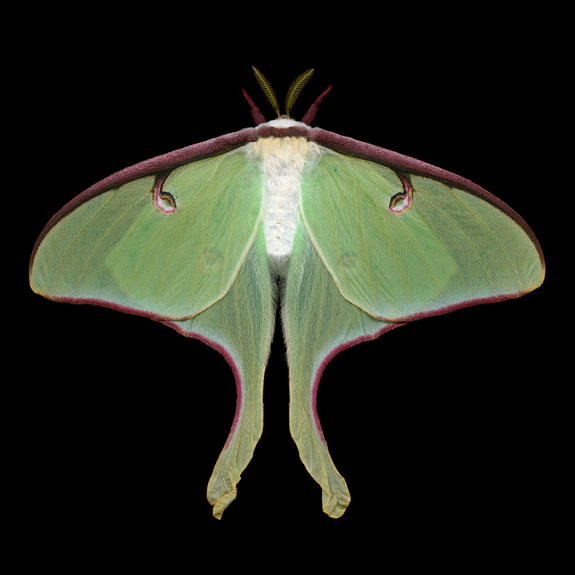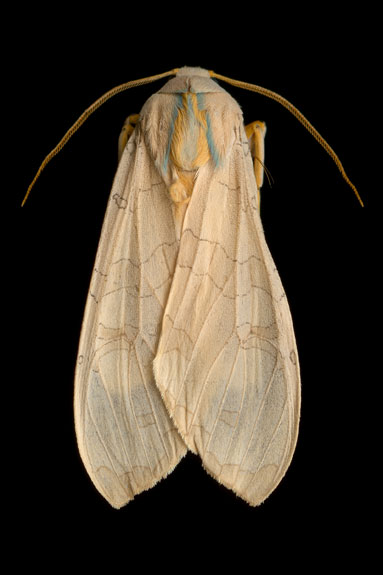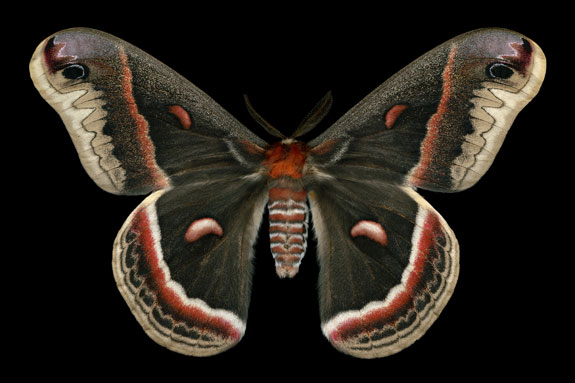Winged Tapestries
Jim des Rivières’ portraits of moths capture the insects’ exquisite patterns
![]()

Luna moth, female (Actias luna), Lac Bonin, Quebec. “The luna moth is the only one that people tend to know by name,” says Jim des Rivières. The moth measures about four inches across. Image by Jim des Rivières.
Jim des Rivières was two years into photographing exotic butterflies, when he realized he ought to turn his attention to moths. Generally speaking, the moth is considered to be the butterfly’s homely cousin. “But the beauty of moths is really quite surprising,” he says.
Since 2002, des Rivières has created breathtaking portraits of about 300 species of moths living in and around his home of Ottawa, Canada. His collection illustrates the great variety of moths, from the Lappet Moth to the Parthenice Tiger Moth to the One-eyed Sphinx (yes, that is its actual name). Each of his large-format prints draws out an individual species’ intricate details—iridescent eyespots, fringed antennae and appaloosa-like spotting.
More than 30 of des Rivières photographs will be on display in “Winged Tapestries: Moths at Large,” a year-long exhibition opening tomorrow at the American Museum of Natural History in New York City.

Great Tiger Moth (Arctia caja Americana), Camp Fortune, Quebec. This wingspan of this moth is about two inches. “The inside of the polka dots is an iridescent blue,” says the photographer. Image by Jim des Rivières.
Collecting Moths
Des Rivières is a computer software engineer by day and a moth collector by night. In the early years of his project, he traveled by car to various wilderness areas within 50 miles of downtown Ottawa. He’d set up an 18-inch fluorescent lamp on stand, similar to those found in bug zappers, and shine it onto a white sheet. Then, he’d wait. “The beauty of the black lighting technique is that the moths come to you,” says des Rivières.
Since then, des Rivières has rented a cottage on Lac Bonin, about 15 miles north of the city. He uses this cottage as a field station during the moth collecting season, which runs from mid-April, when there is “fairly thin pickings,” to early November. “The biggest profusion of species come out in late May and early June in our parts,” he says.
At the cottage, des Rivières checks his “moth trap” three or four times a night; he has his best luck collecting between 10:30 p.m. and 1:30 a.m. He plucks the moths off the white sheet and puts them in little pill bottles. The photographer then identifies each species he has caught using Papillons du Quebec, a book with color plates of all the butterflies and moths of the area, and other field guides. A couple of moth species have eluded him, but, for the most part, des Rivières has captured the incredible biodiversity in his region. “I have found most of the large, colorful species,” he says.

Banded Tussock Moth (Halysidota tessellaris), Crosby, Ontario. “This was an example of the pleasant surprises that I get,” says des Rivières. “When I scanned this moth, it got this teal mohawk.” Its wingspan is under two inches. Image by Jim des Rivières.
Creating the Images
Once des Rivières has collected a moth in a pill bottle, he puts the bottle in his refrigerator. The cool temperature calms the insect; then, to kill it, the photographer transfers it to a jar filled with ethyl acetate fumes. Des Rivières places the moth upside-down on a piece of Styrofoam and pins it into place. “The antennae get very fragile, very quickly,” he says. “Generally, small species take about a day to dry, and larger species maybe two to three days.” As soon as the moth is rigid, he unpins it and scans it on an Epson 4870 flatbed scanner.
Des Rivières magnifies the moths by 10 to 30 times, with his prints measuring upwards of two-by-three feet. To give visitors a sense of the actual size of the moths, which measure about one to six inches from wingtip to wingtip, the American Museum of Natural History has included a display case in its exhibition, containing specimens from its collection of all 34 of the species photographed.

Cecropia Moth (Hyalophora cecropia), Crosby, Ontario. The largest moth species in North America, this moth measures about six inches across. Image by Jim des Rivières.
The Art of it All
The inspiration for the exhibition’s title, “Winged Tapestries: Moths at Large,” came from the Two-Spotted Looper Moth. To the naked eye, the moth appears brown. But when magnified in one of des Rivières’ prints, it becomes clear that the brown is really a mixture of green, purple and orange scales, woven like a carpet or tapestry, on the moth’s wings.
“Each of the individual species is such a wonderful arrangement of colors, shapes and textures,” says des Rivières. “When people refer to my pictures as works of art, I correct them. The moth is the real work of art. If anything, I am trying not to get in the way of people seeing what these creatures actually look like. What I am doing is allowing people, through the magnification, to see what is out there and what has always been out there.”
“Winged Tapestries: Moths at Large,” produced by the Canadian Museum of Nature in Ottawa, is on display at the American Museum of Natural History through September 29, 2013.
/https://tf-cmsv2-smithsonianmag-media.s3.amazonaws.com/accounts/headshot/megan.png)
/https://tf-cmsv2-smithsonianmag-media.s3.amazonaws.com/accounts/headshot/megan.png)